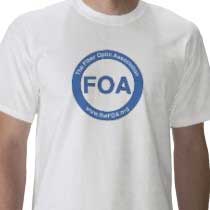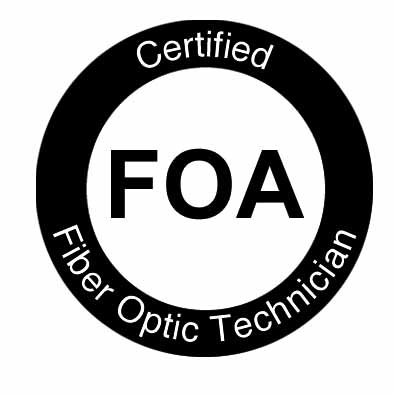Zhone
Passive OLAN Chosen By Washington State University
Zhone
working with Leidos
Engineering installed a GPON OLAN deployment at
Washington State University (WSU). WSU, a public university
located in Pullman, Wash., needed a flexible and
future-looking solution to upgrade the broadband
infrastructure for its on-campus housing. With a student body
of nearly 28,000, WSU selected Zhone's Passive Optical LAN
(POL) solution, FiberLAN, to improve bandwidth availability
and reliability for students living on campus. WSU is
continuing to integrate POL into its own Information
Technology building, and other campus administrative and
housing facilities.
"Today's college students grew up in a connected world, and as
more devices with Internet capabilities are continuously
flooding the market, it's important for campuses like ours to
provide the fast and reliable Internet that students demand,"
said Wallace A. Chase, Information Technology Services Network
Manager, Washington State University. "The flood of broadband
traffic places significant pressure on campus broadband
infrastructures, potentially overloading networks. We decided
Zhone's FiberLAN addressed our needs and provided growth
opportunity, allowing us to affordably upgrade our on-campus
housing to provide students with the bandwidth they desire."
"WSU has seen previous investments in copper cabling become
antiquated and expensive to replace. Leidos Engineering worked
with WSU to develop a vision for the future, and now WSU is
installing single-mode fiber optic cable that will serve them
with incredible access speeds today, as well as decades into
the future," said Matt Miller, Principal Systems Engineer,
Leidos. "Leidos delivered a turnkey POL solution that is
well-suited for WSU's students and IT operations."
Read
more.
President
Obama Visits Midwest, Touts Municipal Broadband, Gets Fiber
Demo

President
Obama visited Cedar Falls, Iowa, in January where Cedar Falls
Utiity has built a 1Gb/s broadband network for the local
customers. Obama was showcasing the advantages of
municipal/utility-owned broadband and vowing to overturn laws
written by CATV and telecom companies that today prevent the
building of such systems in 19 states. Those laws were written
by the Comcast and Verizon after the success of cities like
Chattanooga and Clarksville, TN. Both those cities are now
pursuing legal means to overturn the law in Tennessee that
prevents them from expanding their systems.
Read more from National
Public Radio and The
White House.
Watch
TIA's New CEO Scott Belcher Dance Around Questions About Net
Neutrality
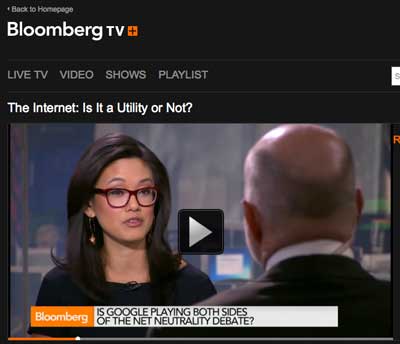
President Obama's stand on net neutrality has prompted
many negative reactions from industry which come from their
aversion to any regulation at all. TIA sent new CEO Scott
Belcher to Bloomberg TV to answer questions on net neutrality
and broadband. Watch him dance around questions about whether
the Internet is a utility or will net neutrality stop Internet
investment (spoiler alert - he says it will!)
You must understand that Belcher is the spokesman for an
industry trade association (not a non-profit, by the way, so
they have no problems lobbying Congress or the Administration)
and is tasked with publicly asserting the views of the
association. Verizon, AT&T and Comcast do not seem to be TIA
members
but they are giant customers for most TIA members. (Full
disclosure: FOA is a TIA member but only for the standards work;
we often publicly disagree with the views of the organization
itself.)
Since Belcher claims the Internet is not a utility, FOA would
like him to answer these questions:
When you are traveling in
rural US and the best you can do is really slow Internet,
would you still say the Internet was not a utility?
Do you really think "cloud computing" can work everywhere in
the US?
How much do you pay (and to whom) for your home Internet
access? How much has it gone up/down in the last 20 years?
Have you speed tested it? (see below) Are you being throttled?
Can we ask your kids if they think the Internet is a utility?
Watch
the Bloomberg TV interview here.
How
Fast Is DSL - Really?
Editorial/Opinion
by Jim Hayes
AT&T
was working on the DSL network near our (JH) office late in
December. I talked to one of the techs on the street about the
intermittent results we had been getting so he set up a service
call. The tech showed up and installed a new DSL modem and
wanted to run a speed test. When I started using my regular
speed test (internetfrog.com) he suggested another
(speedtest.net.) The results were so astounding that I tried
several times again over the next few weeks to see if we got the
same result. It was basically the same, every time.
The AT&T recommended speedtest.net always showed results
like this - ~20Mb/s down and ~2Mb/s up.

But Internetfrog.com gave a startling difference -
~4-6Mb/s down and <2Mb/s up!
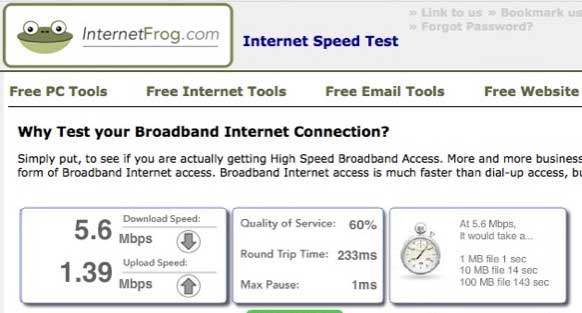
I believe the AT&T test goes to San Diego and
Internetfrog goes to LA, but we are almost exactly the same
distance to each. We've tried this dozens of times and the
different in speed varies from 2X to 6X!
We even had two other local users try the same tests and they
got similar results.
When the AT&T tech was here, we jokingly suggested that
AT&T has a "fast lane" for speed tests using their chosen
provider - sort of the opposite of throttling - but he was a
confused as we were at the results.
Anyone from the DSL side of AT&T want to comment on this?
And maybe you can also tell us why I've gotten ping tests of
over 10 seconds on occasion!
Followup - after this appeared, the next day we got a call from
an AT&T rep asking how our service was doing after the
recent service call. Coincidence? Maybe. But after asking them
about what we had discovered, our access to the AT&T
speedtest was blocked.
Anybody else want to try this with your ISP? Use their suggested
speed test and a different one and see what you find out.
DAS
(Distributed Antenna Systems) Certification Released, Includes
YouTube Video, Web Pages
FOA
has developed a new training curriculum on DAS that shows how
systems are designed and installed. In our training program, we
pay particular attention to the overlay of DAS on premises
cabling systems as they use similar cabling architectures and
components. To complement the DAS curriculum, we have added a
YouTube video, FOA
Lecture 40, DAS - Distributed Antenna Systems. and a page
on DAS on the FOA Online Guide.
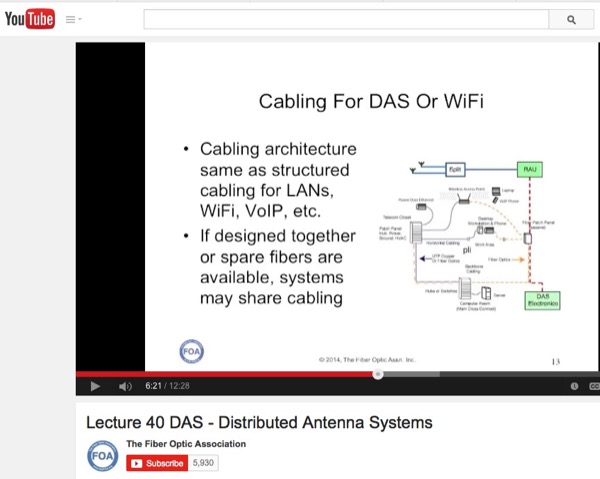
The FOA DAS YouTube video looks at the need for a DAS, how they
are designed, focusing on how they fit into the standard
premises cabling system. Several standards groups are working on
DAS standards, but given their typical speed, one should
probably not expect to see standards for 4-5 years and when
available will probably be obsolete like the TIA standard for
data centers.
In the meantime, you can get information and training from the
FOA. The FOA CFOS/DAS curriculum will be available through FOA
approved schools and will become a online self-study course on Fiber
U soon.
FOA
Lecture 40, DAS - Distributed Antenna Systems
Basic
Skills Lab - A New Fiber
U Online Self-Study Course
FOA just
started a new course on Fiber U that is different and unique,
called "Basic Skills Lab."
In the FOA Online Guide, there are dozens of tutorials that give
instructions and hints on the basic processes used in fiber
optic installation: preparing cables, splicing, termination and
testing. Many of these use a format we call "Virtual Hands-On"
(VHO) where we analyze the process, break it into small steps,
describe each and give hints on how to make it
easier/faster/better. We've used these in teaching these
processes in the classroom for years. By combining them with
YouTube lectures and hands-on videos, this Basic Skills Lab
provides an online way for novices to learn the processes we use
every day in our work and let experienced techs review them and
learn new "tricks of the trade."
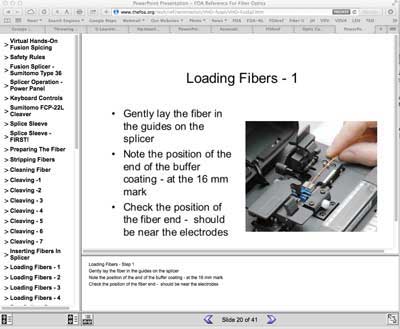
FOA's Splicing Virtual
Hands-On Tutorial
At FOA, we have always adhered to the requirement of KSAs for
technical training and certifications. KSA means knowledge,
skills and abilities. Knowledge you can learn either in a
classroom or online, skills you learn in a lab with an
experienced teacher, abilities are innate - you have to have
certain abilities to do skilled work. The Fiber U Basic Skills
Lab is not a substitute for a
lab with an experienced teacher, but if you have your own
equipment and supplies and like to learn on your own, the
Fiber U Basic Skills Lab can guide you through the processes you
need to know and then you can practice on your own.
There is an important point here. To use the Fiber
U Basic Skills Lab online training properly, you need to have
your own equipment and supplies and like to learn on your own.
FOA sees the
Fiber
U Basic Skills Lab as being best for those already working in
the field who want to learn new skills or novices who have just
started at a company that has equipment and some personnel who
can provide advice and guidance as they learn these new skills.
Here is what the Basic Skills Lab covers
Lesson 1: Introduction, Safety in Working With Fiber Optics
Lesson 2: Fiber Optic Tools and Equipment
Lesson 3: Fiber Optic Cables
Lesson 4: Fiber Optic Splicing
Lesson 5: Fiber Optic Termination
Lesson 6: Fiber Optic Testing
Each lesson has several sections to cover various processes and
components. For example, termination covers epoxy/polish,
anaerobic/polish, HotMelt, prepolished/splice connectors and a
final section on singlemode splicing. Testing includes OLTS and
OTDR testing, of course, but also fiber tracing and visual fault
location, visual inspection of connectors, optical power and
calculating loss budgets. In total there are 24 separate lessons
so it would take a long time to complete them all! Most users
will pick and choose the ones they need most, but we highly
recommend you do every lesson in the testing lesson.
Typical lessons will instruct you to read some materials from
the FOA Guide or textbook, watch a video and then use a "Virtual
Hands-On" (VHO) lesson to step you through the process while
you actually use the equipment to teach yourself the process.
This Fiber U Basic Skills Lab is quite different from
most online courses but we've gotten a lot of input on the
course and those who have tried it like the approach. We hope
you find it helpful and will give us feedback on how we can
improve and expand it.
The Fiber
U Basic Skills Lab is one of the FOA Fiber
U free
online courses.
New
Edition Of Eric Pearson's Fiber Optic "Cookbook"
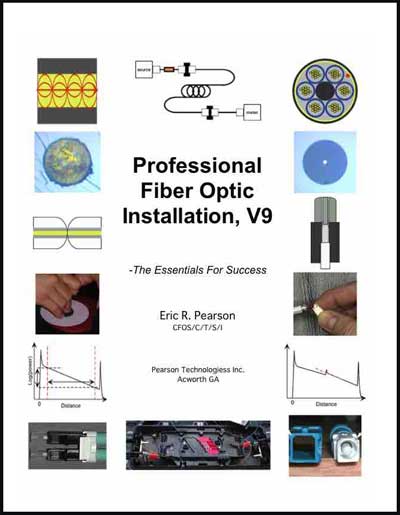
Eric
Pearson of Pearson Technologies Inc. announced the availability
of Professional Fiber Optic Installation, v.9. This
recently updated training, field, and reference text is a
comprehensive presentation of the information essential to
successful fiber optic installation.
This text assists the installer in achieving the three
elements of success: low power loss, high reliability, and low
installation cost. This text is the ideal tool for three types:
those who wish to become professional fiber optic installers;
for instructors who want to use the most comprehensive training
manual available; and for those who want to pass the Fiber Optic
Association CFOT and CFOS/C/S/T certification examinations.
Continuously developed and tested over the last 24 years during
both fieldwork and training presentations, this text includes
both the information essential to understand the reasons for the
installation rules and detailed procedures for installation,
inspection, certification, and testing of cables, connectors,
and splices.
The
new edition, #9, is available on Amazon.com.
OTDRs -
What Is The Problem Here?
FOA Master
Instructor Terry O'Malley, the source of our almost monthly OTDR
articles, sent us this trace with some comments.
Attached is a close up trace that indicates the end of the 3000
meter and the end of the 30 meter and the end of the 9 foot, 2
inch section indicated at about 3.1 meters. Pretty
accurate autotest software placing markers at events but the 9
ft, 2 inch length was not detected in the "Full Auto" mode at a
preset pulse width of 100 ns which is what autotest chose. If
this event was a break in the fiber the "Full Auto" mode at 100
ns would locate it at approximately 2886 meters at the end of
the 30 meters not at the break 9 feet, 2 inches further.
This
situation occurred in the field where an open fiber was
located at a splice point (Full Auto) and the splicers
re-spliced it several (maybe 4-5 times.) They could not
establish continuity. Turns out that with a very short
pulse width and very accurate cursor placement (at last sample
point of backscatter before climbing the fresnel) the fiber
under test was four feet shorter than the mean average of the
rest of the fibers. That led to determining the fiber was
nicked by a box cutter razor used to score the buffer tube.
How many
times have we said something like this: "The use of "Full
Auto" without training and a basic understanding can lead to a
real mess in troubleshooting."
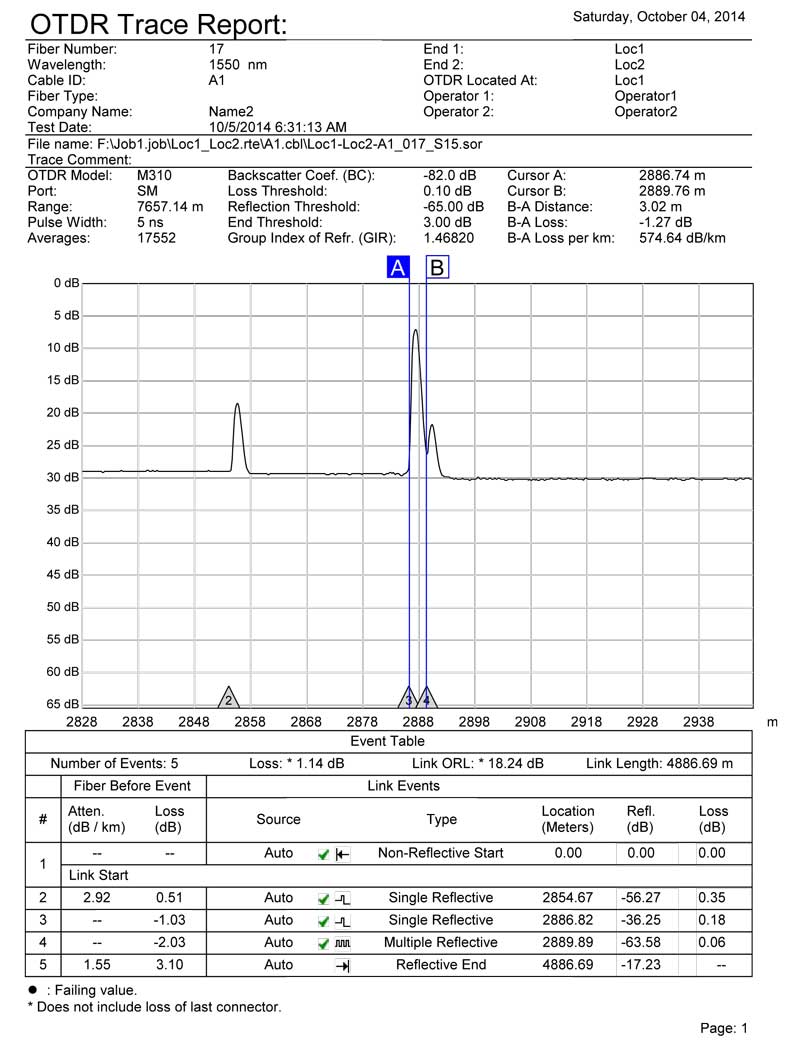
Safety
On The Job
Safety is
the most important part of any job. Installers need to
understand the safety issues to be safe. An excellent guide to
analyzing job hazards is from OSHA, the US Occupational Safety
and Health Administration. Here
is a link to their guide for job hazard analysis.
Worth
Reading: Fiber testing practices are constantly evolving
Patrick McLaughlin, Chief Editor of Cabling Installation &
Maintenance Magazine, has written an excellent article on the
challenges of fiber optic testing. The way Patrick states the
problem is astute: "The medium has proven itself to be stable
and reliable; verifying or certifying that reliability can be a
challenge.
"Many a teacher or trainer in the cabling industry has countless
stories about the frequency with which fiber testing is carried
out incorrectly. In many cases, characterizing the performance
capabilities of installed fiber involves far more than
connecting and pushing the "auto" button on a test instrument. "
Patrick goes on to investigate some of the typical problems
encountered in fiber optic testing and provides to references
(including FOA) that can help you understand the issues and test
properly.
Read
more in CI&M.
More articles in "Worth Reading"
and on the FOA
Pinterest Page "Worth Reading"
FOA
Certifies 50,000th Tech
The FOA passed a milestone in October, 2014 - our 50,000th
certification!
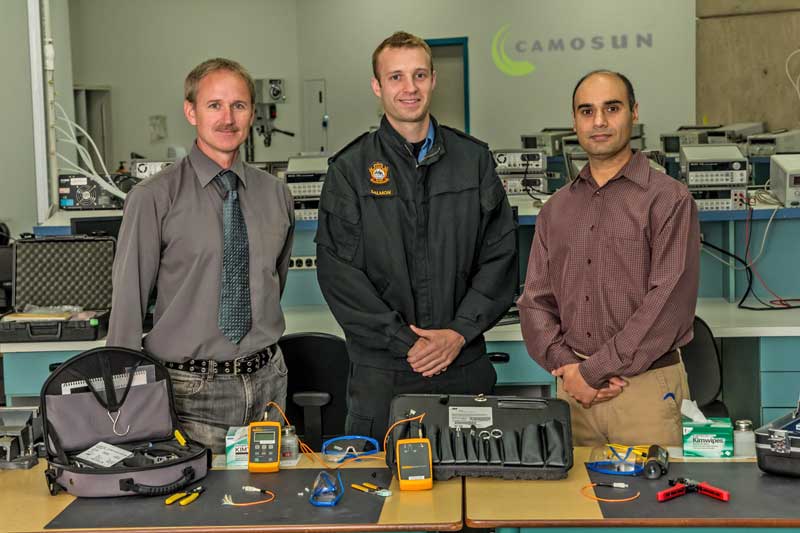
Bradley Salmon, FOA's 50,000th certified tech, with Camosum
College Instructors Trevor Curtis (L) and Gurbinder Dhade (R) in
the Camosun lab.
Congratulations to Bradley, Trevor and Gurbinder - and thanks
for your contributions to the FOA!

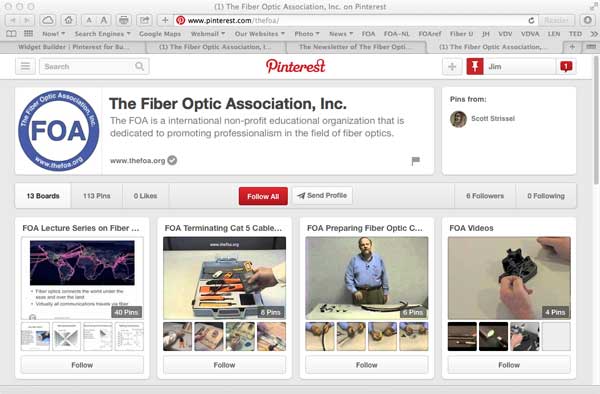
Clean
Every Connector - A Lesson We Learned From Creating Lessons
In creating
the fiber
characterization
curriculum, we got inputs from many experienced techs about the
testing requirements. Everyone we talked to made a big point
about cleaning and inspecting connectors before testing. Dirty
connectors are a major problem with errors in testing. We've
also seen that many installers think that if a connector,
especially new connectors, has a "dust cap" on the connector, it
does not need cleaning. WRONG!
The common name for the plastic caps on connector ferrules is
"dust cap" and a friend says they
are called "dust caps" because they are full of dust.
Those plastic caps are made by the millions, popped out of
plastic molding machines into barrels and stored until put into
plastic bags. Whenever you remove one of them, clean the
connector before testing or connecting it.
More on connector cleaning is here and here.
Good
Practice Tools For OTDRs, All Free
FOA
OTDR Simulator
You
may already know that the FOA has a free OTDR Simulator you can
download from our website (go
here for directions) that allows you to practice using an
OTDR on your PC, seeing the effects of changing setup parameters
and analyzing dozens of real world traces. But here are two more
tools that can be good for practice.
OTDR
FAQs
Including
more hints from FOA Master Instructor Terry O'Malley like tests
on what the end of a fiber trace looks like with broken and
cleaved fibers.
Frequently
Asked Questions On OTDRS And Hints On Their Use
"Fiberizer"
APP Reads, Analyzes OTDR Traces
Fiberizer
is a iPhone/iPad APP that reads industry-standard ".sor" format
files and allows trace analysis on your iPhone or iPad. An
android version is in the works too. Read
more about Fiberizer. And
here are more directions on its use.
FOA Now
Offers Fiber Optic Textbook and Web Pages In Spanish (French
Online Guide available, textbook coming soon)
Guía
de Referencia de la Asociación de Fibra Óptica (FOA) Sobre
Fibra Óptica
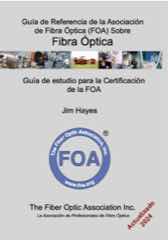
Guía
de estudio para la certificación de la FOA
Este libro es una guía de diseño e instalación para redes de
cableado con fibra óptica. Fue escrito como un libro de
referencia para los instructores y estudiantes en clases para
certificación CFOT FOA, así como una referencia para cualquiera
que trabaje en el campo. Este libro ofrece una cobertura amplia
de los componentes y procesos de fibra óptica que se utilizan en
todas las aplicaciones y prácticas de instalación.
Disponible desde CreateSpace,
Amazon.com
y muchos otros libreros
Available from CreateSpace,
Amazon.com
and many other booksellers

Qué es la FOA (What Is The FOA, in Spanish )
Plus,
FOA Now Offers Its Basic Fiber Optic Online Guide Website In
Spanish
La guía
básica de fibra óptica de la FOA ha sido traducida al español.
Es la versión completa de la FOA Guía básica Online traducido
por especialistas técnicos, incluyendo todos los dibujos. Por
favor, lea o comprar una copia del libro impreso y nos dan su
opinión sobre cómo podemos mejorarlo!
Léela aquí.
Si
usted está enseñando a la fibra óptica, póngase en contacto con
nosotros ya que estamos ahora traduciendo el programa de
formación FOA CFOT también.
If
you are teaching fiber optics, contact us as we are now
translating the FOA CFOT training curriculum also.
OLANs -
Optical LANs
Free
Fiber U Optical LAN (OLAN) Self-Study Program
FOA has
added a new Fiber U self-study program on Optical LANs (OLANs).
As you know, this is a hot topic in the IT world, so FOA has
created an online course that allows you to study about OLANs
(FOA includes fiber to the desk, fiber to the office and passive
optical LANs) on your own time and schedule. You will be guided
to material to read, videos to watch and even have quizzes to
check your comprehension.
All Free!
OLANs
on Fiber U
FOA
OLAN Certification Released
OLANs are
probably the most important new technology for enterprise
networks since the introduction of structured cabling standards
22 years ago. For
the last few months, FOA has been working with companies and
groups interested in OLANs to create a certification for techs
designing and installing them.
With OLANs, FOA has worked with leaders in the field to create
technical materials on our FOA
Guide website, Fiber
U self-study program and YouTube
channel already. We now have a curriculum ready our
FOA-Approved schools which will make OLAN training available for
those interested. Read
More.
OLAN
Resources
Over the
last couple of years, we've written a lot about Optical LANs,
either based on FTTH passive optical network (PON) or
point-to-point (P2P) Ethernet architecture. The more we see of
these types of networks, the more we appreciate their design and
economy. But how about scale - how big can they get?
In November, we ran a picture
story about the new San Diego Central Library which is
using a Tellabs optical LAN using PON technology that was using
about 1000 4 port drops. Now we hear another Tellabs customer
has over 16,000 users. That must make it one of the biggest LANs
in the world.
Here
are more sources of information on optical LANs - BTW, they need
a name - let's start calling them OLANs!
FOA
Guide Page on OLANs and FOA
YouTube Video
APOLAN,
trade association for Optical LANs website
http://www.apolanglobal.org/
RETURN
TO INDEX
Events of
Interest
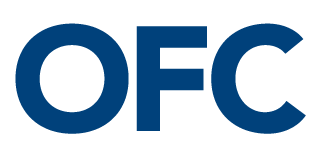
OFC
Coming Back To LA
The long-running OFC (Optical Fiber Communication) Conference
co-sponsored by OSA and IEEE ComSoc is coming back to LA March
22-26, 2105 at the LA Convention Center. OFC is one of the
world's top conferences for fiber optics. It's an interesting
place to meet manufacturers (about half are now from the Far
East) and unless you have at least a Ph.D. and are working on
next-generation communications, the conference sessions are not
very interesting. But it's a good place to visit for a day and
see what's available on the market.
More
on OFC.
Don't
Miss These Seminars and Webinars:

Free
Webcast: Best Practices for Deploying Preterminated
Fiber-Optic Systems - Presented by FOA's Jim Hayes
Available
anytime
Sign
up here.
The
popularity of preterminated fiber-optic systems continues to
rise, as network owners realize the multidimensional benefits
of these cablingsystems in several environments. Whether it is
between servers inside a data center or between wireless
towers outdoors, a preterminated fiber-optic cablingsystem
offers efficiency in the fiber-connectivity process. These
systems, however, do require careful forethought, planning,
acceptance and, yes,installation. This webcast seminar,
produced by Cabling Installation & Maintenance and
delivered by Fiber Optic Association president Jim Hayes,
describes the requirements and best practicesof deploying
preterminated or “prefabricated” fiber-optic cabling. It
covers the necessities of acceptance inspection, cleaning and
testing, as well asproper design and installation techniques.
Sign
up here.
~~~~~~~~~~~~~~~~~~

Design
& Deployment Best Practices for Reliable Industrial Fiber
Optic Networks
Presented by Robert Reid, Panduit
Available anytime (https://www.brighttalk.com/webcast/727/137229)
Avoid EMI while achieving longer distances and higher
performance utilizing fiber optics for EtherNet/IP networks
across manufacturing zones and devices. In this webinar, you'll
hear about physical layer best practices and understand proper
fiber media selection for each physical layer in the EtherNet/IP
network. We will review design recommendations and
considerations to help you successfully deploy a robust and
secure plant-wide implementation of EtherNet/IP
TIA FOTC offers regular
webinars and archives
them here so you can watch anytime.
~~~~~~~~~~~~~~~~~~~
 New
local programs for fiber installation training New
local programs for fiber installation training
See
the Light® Fiber Optic Training Program
Webinars, seminars and certification training classes.
Corning offers a library of
more than 200 hundred videos that help our customers
with everything from product preparation and installation to
proper testing procedures. Our free Video Library Tool provides
direct links to individual Corning videos, and allows you to
filter by topic or area of interest. Register
to download the Video Library Tool.
~~~~~~~~~~~~~~~~~~
RETURN
TO INDEX
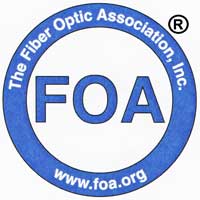 What's
Happening @ FOA What's
Happening @ FOA

FOA
has three LinkedIn Groups
FOA
- covers FOA, technology and jobs in the fiber optic marketplace
FOA
Fiber Optic Training - open to all, covers fiber optic
technology and training topics
FOA
School Instructors - a closed group for instructors and
administrators at FOA-approved schools
Grupo
de La Asociación de Fibra Óptica FOA (Español)
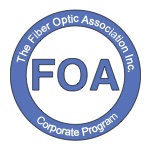 Corporate
Memberships Corporate
Memberships
FOA is now
offering corporate memberships to companies involved in fiber
optics as manufacturers, contractors, installers, etc. Corporate
Membership gives companies discounts on memberships and direct
certifications and access to special FOA materials for educating
customers and employees. Read
more.
FOA
Standards:
FOA now offers free standards for datalinks and testing the
installed fiber optic cable plant, patchcords and cable, optical
power from transmitters or at receivers and OTDR testing.
What
Is A Fiber Optic Cable Plant?
In a recent
standards meeting, that issue was discussed with some
disagreement as to what constituted a "cable plant." It seemed
to be a perfect topic for another FOA "1Page Standard," so a
draft version is now uploaded for review (FOA
Standard FOA-6, Fiber Optic Cable Plant). Feel free to
review it and comment to the FOA at info@thefoa.org.
Available
also is a new standard for Datalinks.
Look for the "1
PageStandard" web page and in the FOA Online Reference
Guide.
Go to the
FOA "1
Page Standards"
Free
For FOA Members: NECA/FOA 301 Fiber Optic Installation
Standard
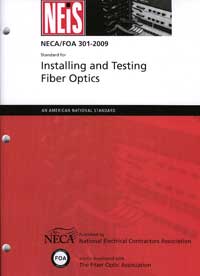
Standards
cover components and systems and how to test them, but rarely
get into installation issues. The FOA NECA 301 standard which
covers installation of optical fiber systems has been revised
for the second time, adding considerable new materials. This
standard is derived from FOA educational material put in
standards form and approved by ANSI as an American National
Standard. It's specifically written to be used in contracts to
define "installation in a neat and workmanlike manner." The
standard is available from NECA.
FOA members can go
here for instructions on how to download your free copy.
RETURN
TO INDEX
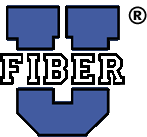
Free
Fiber U Self-Study Programs
FOA's
"Fiber U" free online self-study programs help you learn about
fiber optics, study for FOA certifications or use them to help
create "blended learning" classes. There are two new free online
self-study programs on Fiber
U. Fiber Optic Network Design is for those interested in
learning more about how to design fiber optic networks or
studying for the CFOS/D certification. FTTx is for those wanting
to know more about fiber to the "x" - curb, home, wireless, etc.
- or studying for the CFOS/H certification.
Got to Fiber U
for more information.
FIber U
"Basic Fiber Optics" and "Premises Cabling" Online Self-Study
Programs Offer Option Of Certificate of Completion
FOA has
been offering quite a few free online self-study programs on Fiber
U, our online learning site. We are always getting
questions about getting a certificate for completing the course
online, so we have setup an option to take a test online and get
a certificate of completion for these two online courses.
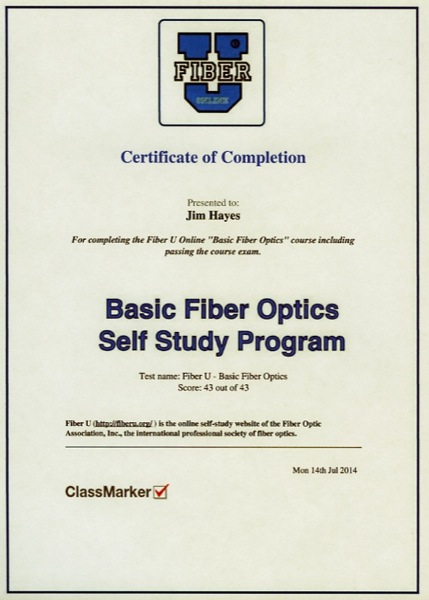
While it's not FOA certification, FOA will recognize a Fiber
U Certificate of Completion as background experience to
qualify for applying for FOA certifications. We also intend to
expand the program to more specialized topics as preparation
for FOA specialist certifications.
If you have associates that want to get started in fiber,
have them take this course online to get started. Go to Fiber
U and get started.
Lennie
& Uncle Ted Now Available As Free Books on iTunes
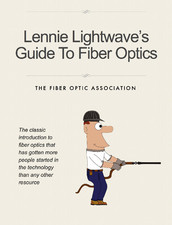
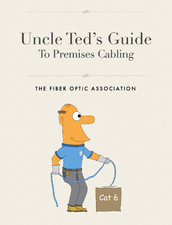
Lennie
Lightwave's Guide to Fiber Optics and Uncle Ted's Guide To
Premises Cabling are now available free to iPad users who can
download them from the Apple iTunes store.
Lennie's
Guide has always been the world's favorite introduction to fiber
optics. It was first published in the mid-1990s by Fotec, the
fiber optic test equipment company famous for its "Fiber U"
training conferences and more than 60,000 printed copies were
distributed. Lennie was one of the earliest commercial webpages
and is still online today (and as popular as ever) at http://lennielightwave.com.
Uncle
Ted's Guide was created at the request of Lennie readers
who wanted a similar simple introduction to "Cat 5" wiring. This
latest version of Uncle Ted's Guide covers the all premises
cabling topics - wiring, fiber and wireless.
You can find these free guides on Apple's iTunes Store: Lennie
Lightwave's Guide to Fiber Optics and Uncle
Ted's Guide To Premises Cabling
FOA Now
Offers Fiber Optic Textbook In Spanish (French coming soon)
Guía de
Referencia de la Asociación de Fibra Óptica (FOA) Sobre Fibra
Óptica

- Reference
Books for FOA Certifications available on Kindle and
iPad/iPhone as well as printed
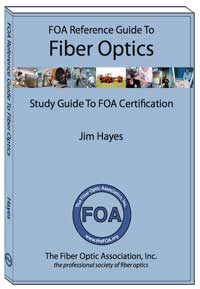
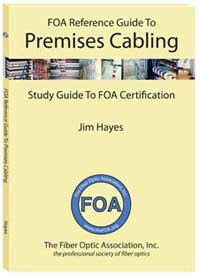
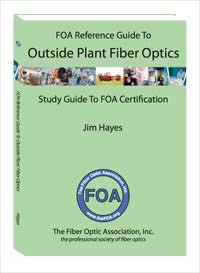
We have created three new FOA books to be used in training for
FOA certifications and as reference books for contractors,
installers and end users of fiber optics. These books have
full curriculum support, including free curriculum materials
for teaching FOA certification courses. Because we are
self-publishing these books using more modern "publish on
demand" technology, they are easier to keep up to date, easier
to buy and much, MUCH cheaper!
All
are now available in print and electronically in Kindle and
Apple iBook versions. The basic fiber optic book is also
available as a self-study program in an Apple APP for
iPad/iPhone/iPod.
Details on the new book each of the new books are at the book
pages linked to the photos above.
RETURN
TO INDEX
FOA
iPad Apps
The FOA
has just released its second APP for the iPad, a free "loss
budget calculator," FOA LossCalc.
FOA
LossCalc
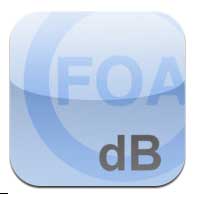 FOA
LossCalc estimates the optical loss of a fiber optic link. This
will save time for the installer of a fiber optic link needing
to know whether test results are reasonable and/or make a
"pass/fail" determination. It can also help the designer of a
link to determine if communications equipment will operate over
this link. FOA
LossCalc estimates the optical loss of a fiber optic link. This
will save time for the installer of a fiber optic link needing
to know whether test results are reasonable and/or make a
"pass/fail" determination. It can also help the designer of a
link to determine if communications equipment will operate over
this link.
By choosing the type of link (singlemode or multimode) and
specifying the length of the fiber and numbers of connections
and splices, it will calculate the end to end loss of the link.
The app has default specifications for singlemode and multimode
links or the user may create custom setups with specifications
appropriate for any application. http://itunes.apple.com/us/app/foa-losscalc/id476262894?mt=8&ls=1
Self -Study in Fiber Optics
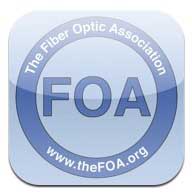 Our
first app is a self-study version of the FOA Reference Guide to
Fiber Optics. The FOA APP builds on the FOA basic fiber optic
textbook to create an interactive learning environment that
builds on the iBook electronic version of the book to add a
guide to use for self-study and real-time testing that provides
feedback on what you have learned and correct answers to
questions answered incorrectly. Our
first app is a self-study version of the FOA Reference Guide to
Fiber Optics. The FOA APP builds on the FOA basic fiber optic
textbook to create an interactive learning environment that
builds on the iBook electronic version of the book to add a
guide to use for self-study and real-time testing that provides
feedback on what you have learned and correct answers to
questions answered incorrectly.
The FOA APP is priced at only $9.99, same as the iBook, so the
self-study program is free. Download it from the Apple APP Store
with your iPad or iTunes.
http://itunes.apple.com/us/app/foa-guide/id434354283?mt=8&ign-mpt=uo%3D4
FOA
"Quickstart Guides"
In our
continuing quest to help people understand how to test fiber
optic cable plants and communications systems, we've created two
more "QuickStart Guides to Fiber Optic Testing." They are
simple, step-by-step guides on how to test fiber optic cable
plants, patchcords or single cables using insertion loss or OTDR
techniques and optical power from transceivers. It's as
straightforward as it can get - what equipment do you need, what
are the procedures for testing, options in implementing the
test, measurement errors and documenting the results.
It can't get much simpler.
Send anybody you know who needs to know about fiber optic
testing here to learn how it's done in a few minutes.
Testing
Fiber Optic Cable Plants And Patchcords
Testing
Fiber Optic Cable Plants With An OTDR
Measuring
Optical Power In Communications Systems
RETURN
TO INDEX

The
FOA has many videos on  ,
including two Lecture Series (Fiber Optics and Premises
Cabling), Hands-On lectures on both and some other informational
and instructional videos. For all the videos, go
to the FOA Channel "thefoainc" or use the direct links
below. ,
including two Lecture Series (Fiber Optics and Premises
Cabling), Hands-On lectures on both and some other informational
and instructional videos. For all the videos, go
to the FOA Channel "thefoainc" or use the direct links
below.
Two New
Applications Videos
To
accompany new FOA certifications in FTTA and Data Centers
FOA
Lecture 37: FTTA (Fiber To The Antenna) and Data Center
Cabling
FOA
Lecture 38: Data Center Cabling
FOA
Product Demonstrations
In the June
FOA Newsletter, we talked about the new #M "disposable" cleaver,
the Easy Cleaver, which is provided free with 3M connectors and
mechanical splices that need cleavers. We got samples of the
Easy Cleaver from 3M and tested them ourselves, and they work
great. You can see for yourself how they work in this FOA
YouTube Video about the Easy Cleaver.
We also tested the new Ripley/Miller FO-CF Center Feed Fiber
Stripper and used it as an opportunity to show the other three
common types of strippers, the Miller, MicroStrip and NoNik and
how they are used. So you get a review of how to strip fiber and
a product review of the new stripper in this FOA
YouTube video about fiber strippers.
New FOA
Lectures And Hands-On Videos
How
to Talk Fiber Optics -
an introduction to fiber optic jargon - the perfect place to
start learning about fiber optics.
Where
Are The Jobs In Fiber Optics? FOA talks about all the
applications for fiber optics, what jobs involve and the
qualifications for the workers in the field.
What's
A "Network"
That's a
common question from fiber and cabling people. Even though they
may be installing the cable plants for networks, often the
nature of networks is not something they have been exposed to,
other than perhaps the catch-all "star network" description. But
what is a network? What does it connect? How does it connect
users and how does it allocate the bandwidth to them? How do
various network types vary?
We've been working on some new YouTube videos on networks,
starting as we usually do on a new subject with the basics. We
have these three videos online now, but watch for more.
Fiber
Optics - Live! A
series of videos that use lab demonstrations to show how
optical fiber works.
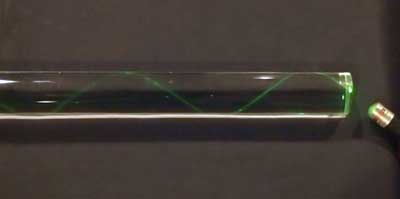
Prepolished/Splice
Connector Termination (Panduit OptiCam)
Cabling
Project Management - what's involved in a
copper/fiber/wireless project -advice for the customer and the
contractor
Hazards
Of Counterfeit Cable
You may
have read the stories we have written about the counterfeit
"Cat 5" cable made from copper-clad aluminum rather than pure
copper. Recently we tried an unscientific burn test on the
cable compared to a known good UL tested cable and posted a
video on YouTube. You can see the results below.
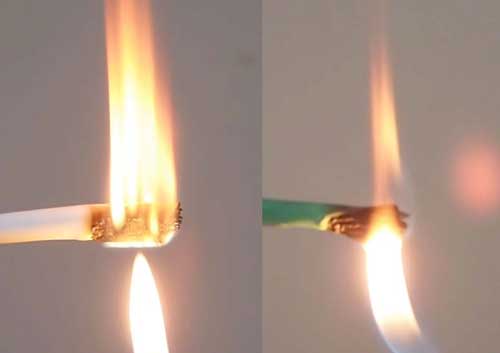
Counterfeit
Cable Real UL-rated cable
The
difference is obvious and the danger is real. Watch the video
on YouTube: Premises
Cabling Lecture 11: Counterfeit Cat 5 Cabling
View a
complete list of FOA Videos with links to each video on
YouTube.
View
all the FOA Channel on YouTube.
RETURN
TO INDEX

What's
New in the FOA Online Fiber Optic Reference Guide?
We have
been updating the Online Reference Guide to keep up with changes
in the industry and adding lots of new pages of technical
information.
Fiber Supports Wireless: FTTA
and DAS
FOA
Guide page on Metrology-
the accuracy of measurements
Updated page on Data
Centers
Le
Guide de référence pour la fibre optique de la FOA est
maintenant disponible en français.
Updates
for new FOA certifications in FTTA
and Data
Centers
What do you do when you need to test fiber or
cable on a reel? Here is a new page on Bare
Fiber Testing
Couplers or splitters are used in FTTH and OLANs. How
do you Test Splitters?
Tapping fiber has been a big topic in the news. How
do you tap fiber?
The page on Optical
LANs (OLANs) has been expanded with new material and
links.
What's
A Network? A simple explanation of network types and
operation has been added to the FOA Online Guide.
We
have updated the
"Datalinks"
page.
Three
new "Quickstart Guides" for fiber optic testing: cable
plant & patchcord loss, power
and OTDR
Learn
More About OTDRs - Download a Free OTDR Simulator
More and more installers are being asked for OTDR testing but
using these instruments is not easy. They are hard to set up
properly and complicated to interpret the traces. Using the
autotest function can lead to disastrous results! The FOA has a
good tutorial on OTDRs on our Online Reference Guide and we
added a free download of an OTDR
simulator to the OTDR
section so you can learn how to use an OTDR on your PC.
More
New Info:
Links
to manufacturers
and distributors of fiber optic lighting products.
The
FOA Online Fiber Optic Reference Guide has become very
popular - perhaps the most popular technical website ever,
typically with over 360,000 users downloading about 1.75 million
pages in 2011! We continue updating materials regularly, keeping
it as up to date as possible.
Find
What You Want Using "Google Custom Search
 There's
so much information on the FOA Tech Topics and Online Fiber
Optic Reference Guide that even a well-organized Table of
Contents isn't enough and when the material is always changing,
an index is impossible to maintain. So the FOA is using the
latest technology in search, Google Custom Search, which will
allow you to search just the FOA Tech Topics and
Online Fiber Optic Reference Guide for any topic you want to
find more about. Try
it! There's
so much information on the FOA Tech Topics and Online Fiber
Optic Reference Guide that even a well-organized Table of
Contents isn't enough and when the material is always changing,
an index is impossible to maintain. So the FOA is using the
latest technology in search, Google Custom Search, which will
allow you to search just the FOA Tech Topics and
Online Fiber Optic Reference Guide for any topic you want to
find more about. Try
it!
Go
to The
FOA Online Fiber Optic Reference Guide.
RETURN
TO INDEX
New
Schools
The FOA welcomes the newest additions to our listing of FOA-Approved
Training Organizations:
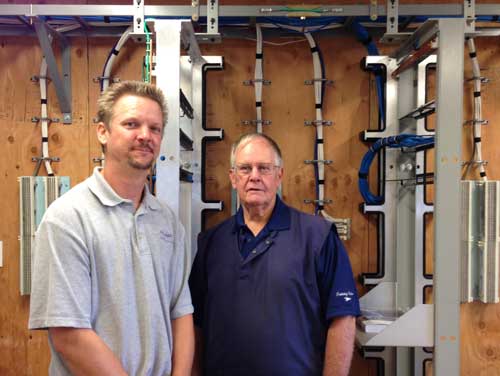
Jeff Moser,
Instructor and Charles Headington, Training Director
San Luis
Obispo Electrical Workers JATC
San Luis Obispo, CA 93401
CFOT, FOA Approved School #648
Find
a listing of all the FOA-Approved schools here.
Find
A FOA-Approved Training Organization
Most
inqiries we get regarding finding a FOA-Approved training
organization want to know two things: what school is closest to
me or what school offers the certifications I need. The FOA has
about 200 training organizations we have approved worldwide so
finding the right one can be difficult! We've been looking at
ways to make it easier, and we think we've got a good solution.
In fact we have two solutions.
First we have added a sortable
table of all the FOA-Approved schools.
You can also use our FOA
Google Map to find FOA-Approved schools.
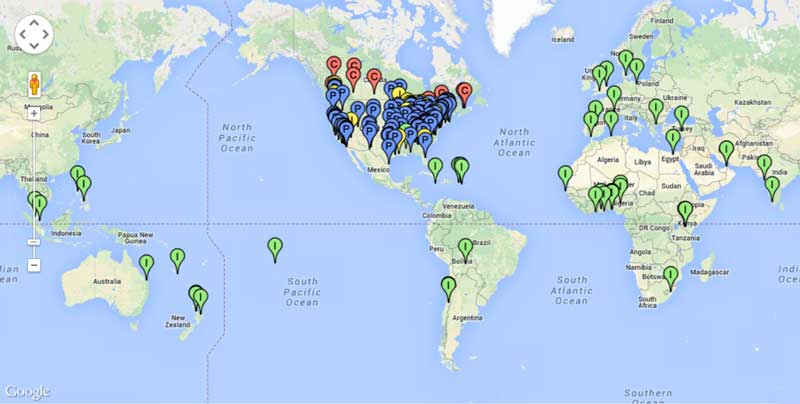
What
Should A Fiber Optics or Cabling Tech Know and What Skills Do
They Need?
FOA
certifications are based on our KSAs - the Knowledge, Skills and
Abilities that techs need to succeed. Read the FOA KSAs
for fiber and cabling techs.
School News
Feedback
We always
enjoy feedback, especially when it shows how great some FOA
instructors are. These came from students of Tom Rauch, an
instructor at BDI
Datalynk:
"I took your fiber optics certification courses this past March.
I just wanted to let you know that in two weeks I start working
as a fiber optic technician with ___ up in ___. You mentioned on
the first day of the course that there is always one guy in
class who had rubbed his last two nickels together to be there
and, in that instance, I was that guy. Now I'm going to be able
to provide for my family like never before and I owe it to the
certification that I received from you and BDI Datalynk. I just
wanted to thank you again."
"Thanks to our tremendously knowledgeable and patient instructor
Thomas Rauch, who was not only generous in sharing his wealth of
information, but he did so with ease, humor and in a way that
invited curiosity and participation. He was encouraging and
proud of our accomplishments and helped us learn from our
mistakes in a way that did not break our confidence, rather it
pushed us to better results the next go around. The hands on
labs were just AWESOME!" Just thought you should know what a
class act you have representing you in his travels..... but then
again you probably already knew that! : )
In almost 19 years at Verizon and having held numerous
positions, I have gone through many training sessions. I cannot
remember ever having been actually looking forward to coming
back to class quickly after lunch, to get back to the hands on
activities, and walking away with the sense of empowerment that
the information presented was not only relevant but dead on
point accurate! I will be signing up for the Outside Plant class
on March! I can't say enough good things about Tom and his
impact! Feel free to quote me, I can only imagine that he will
open so many doors and change so many lives in the years to
come, with his style of teaching! Great experience, awesome job!"
IBEW
and FOA Partner on Fiber Optic Training
The
International Brotherhood of Electrical Workers (IBEW) and the
National Electrical Contractors Association(NECA) through the
National Joint Apprenticeship and Training Committee
(NJATC) in
a partnership with the FOA has published a new textbook for
training IBEW apprentices and journeymen in fiber optics. The
new textbook uses the material from the FOA Reference Guide To
Fiber Optics with new material and photos from other NJATC
training partners.
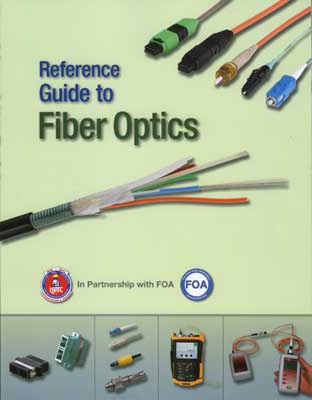
FOA is pleased to have been able to assist the NJATC in the
development of this new text. FOA has been a NJATC training
partner for many years, including offering instructor training
at more than 16 of the NJATC's summer National Training
Institutes. A majority of IBEW NECA contractors do fiber optics
and low voltage, especially for applications that combine
electrical and communications cabling like smart grid,
alternative energy, traffic controls, data centers, etc.
Quote
from one of our certified instructors: I want to thank
you and your organization for all the resources you provide for
the students and the opportunity to offer the certification to
the students. The fact that you published the book yourself to
get the cost down and the unlimited free resources on your
website shows a commitment to the public that is second to none.
I let it be known to the students that the FOA is the best in
the industry at supplying knowledge and resources related to the
communication industry. I look forward to passing on the
information that you provide for the industry.
Great
Video About An FOA School And Their Training
BDI
Datalynk trains at the Unversity of Central Florida. UCF
created this incredible video on the BDI Datalynk program.
It shows the power of what they
offer on campuses around the US.
Watch the video here: http://www.ce.ucf.edu/Program/2583/Fiber-Optics-Network-Certification-Courses-Non-credit/
For more information, contact Bob Ballard, CFOS/I, BDI DataLynk,
LLC, A Vietnam Veteran-Owned Company
www.bdidatalynk.com,
Ph: 512-785-9024
RETURN
TO INDEX
Good
Question! Tech Questions/Comments Worth Repeating
Real
Questions From FOA Newsletter Readers
Span
Length For Aerial Cable
Q: Can the spacing
between poles be 400m for installing light optical fiber cable?
A: There is no general
answer to that question. We are aware of aerial cables going at
least twice that far but it requires coordination with the cable
manufacturer and choice of the proper cable. So the tentative
answer is "probably" but you need to consult a cable
manufacturer.
Storage
of Optical Cale
Q: I would like to know that the procedure for long
time storage and preservation of fiber optic cables.
A: The preferred
guidelines are fairly simple - store the cable on the reel in a
indoor dry location where the temperature is moderate - say
10-40deg C- and humidity is also moderate. Have the spools
sitting on the edges or on a spindle (see
Nexans guidelines here).
Multimode
Fiber at 1550nm
Q: Is there a reason why wavelength 1550 would not work
on M.M optical fibre?
A: 1550nm will work on
MM fiber. It has not been used very much because 1550 is mostly
used for it's low loss that allows longer distances which is
more appropriate for SM fiber. Many years ago (late 1980s) NASA
used 50/125 MM fiber at Cape Canaveral with 1550nm sources to go
relatively long distances (~15km) over MM fiber because they had
shorter links that were patched together.
OTDR
Loopbacks
Q: We are looking at running a OTDR test across a pair
of fibre’s but instead of running a OTDR test from A-B and then
B-A, we are looping the fibres at exchange B and doing the OTDR
test at on F1 &2 at Site A. We have launch cords and trail
leads on Fibres one and two but I’m wondering what length of
fibre should the loop be, would 50m be acceptable. Typically the
sites are 10-20km apart.
A: Loopback tests are a
good way to simplify OTDR testing. On a 10-20km run, the
loopback needs to be long enough to allow both connections on
the far end to be seen, so it depends on the pulse width of the
OTDR. I suspect 50m is too short - I’d say use 500-1000m to
ensure all the data is valid.
OTDRs
On Live Networks
Q: I want ask you about OTDR measurment on live
network. Is it mandatory to disconnect the far end patch cord
before taking OTDR measurment . On our back bone network will an
OTDR power is afect or damage line cards?
A: It depends on the
network equipment - we would not recommend testing with
equipment connected as OTDR pulses are very high power and will
overload receivers. Do not take a chance!
Manufacturing
Guide?
Q: Is there a guide published by FOA that provides
insight as to the process of fiber optic manufacturing? It's my
understanding that the guide stresses quality and controls to
ensure performance and reduce product loss?
A: We do have a guide
for manufacturers. It is mostly aimed at communications systems
and components manufacture. Here
is a link to download it.
How
Long Does Termination Take?
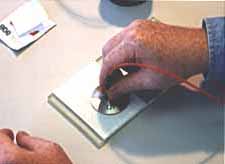
FOA received a request from a consultant recently wondering if
we had information on the termination times for fiber optic
cables. After some looking in our archives, we realized we had a
document online that compared times for various fiber optic
termination processes. The paper was written after several FOA
instructors did a comprehensive time and motion study on
termination processes. The document is about 15 years old but
still relevant.
You
can read it here in the FOA Online Guide.
Q:
I would like to ask a question about GPON security...is it
possible to eavesdropping of the shared broadcast traffic from
the OLT
A: GPON signals
downstream are encrypted to prevent eavesdropping.
Connectors
Q: I have a 62.5 micron fiber and 50 micron connectors.
We only need 62.5 capability. I have the tools to put the
connector on the cable but will this cable work?
A: There are several
ways to interpret your question.
1) If you are talking about adhesive/polish connectors, the hole
in the connector is the same for 50/125 and 62.5/125 micron
fibers, so the connector itself is the same.
2) If you are talking about prepolished/splice connectors where
you cleave a fiber and insert it into the connector without
polishing, you must have connectors with the proper size fiber
or you can incur 2-4dB loss going from 62.5 to 50 micron fiber.
See this page in the FOA Guide: http://thefoa.org/tech/fib62-50.htm
More info on termination can be found on the FOA Guide:
Fiber optic connectors: http://thefoa.org/tech/ref/OSP/term.html
And you can search the FOA Guide with our Google Custom Search:
http://thefoa.org/tech/ref/contents.html#Test
Testing
Connectors (From A Patchcord Maker)
Q: What are the chief defining standard(s) that
specifies connector and assembly IL (insertion loss) and RL
(return loss or reflectance) for both SM and MM fiber?
A: The description on
our Guide is here: http://www.thefoa.org/tech/ref/testing/test/conntest.html
FOTP-34 covers connector testing as a qualification test
for the type of connector - basically a "destructive" test for
connector manufacturers.
Reflectance is described on that page and here also: http://www.thefoa.org/tech/ref/testing/test/reflectance.html
Testing an assembly like a patchcord is covered under
FOTP-107 http://www.thefoa.org/tech/ref/testing/test/FOTP-171.html
Basic
Tests For Fiber Optic Cable Plants
Q: I did some research and I noticed that there is a
bunch of tests that can be done to fiber optics and I was
wondering if there is a list of primary tests that can be done
as a basic test.
A: Fiber optic testing
does have a hierarchy of tests.
- At
the top of the list is "insertion loss" testing which uses a
light source and power meter to test the fibers in the
same way that a communications system transmits over the
fiber. It is a simple test and the equipment needed is
inexpensive.
- Techs
will also use a microscope to inspect the fiber optic
connectors for dirt and damage, a big issue for fiber.
- The
instrument called an "OTDR" takes a snapshot of the fiber
using a technique like radar. Most outside plant cables are
tested with an OTDR and the data ( the snapshots are called
"traces") stored for future reference. OTDRs are more
expensive and require more training to use properly.
Here is a
link to a page on the FOA Guide site that explains the
technical,details: http://thefoa.org/tech/ref/testing/test/OFSTP-14.html
FOA also has information just for users of fiber optic networks,
see http://thefoa.org/tech/guides/UG3.pdf
Relative
vs. Absolute Power Measurements
Q: I am
thinking how to minimize uncertainty when doing relative
measurements. I am mostly interested not in absolute power but
rather a relative one, that is measuring loss not absolute
power. Will any source of error be smaller or maybe vanish
as a result of ratio? What can I do to reduce the uncertainty of
the ratio of powers?
A: When measuring relative power, e.g. when measuring loss, the
issue is relative power and depends on the linearity of the
meter. The linearity of the meter can be affected by two issues
- the slope of the calibration curve and the offset where the
meter autoranges. Most meters read power over a large dynamic
range, 1,000,000 to 1 (60dB) is not uncommon, and that is beyond
the range of the electronics in the meter. To get this kind of
range, the meters have a range switch controlled by the
microprocessor that changes the gain in the amplifier attached
to the detector. The amplifiers are linear and dB is calculated
by the microprocessor so it does not matter if you measure in dB
or W and calculate dB yourself. Calibration of the meter should
include looking at the autoranging points to ensure minimal
nonlinearity. Look at this graph:
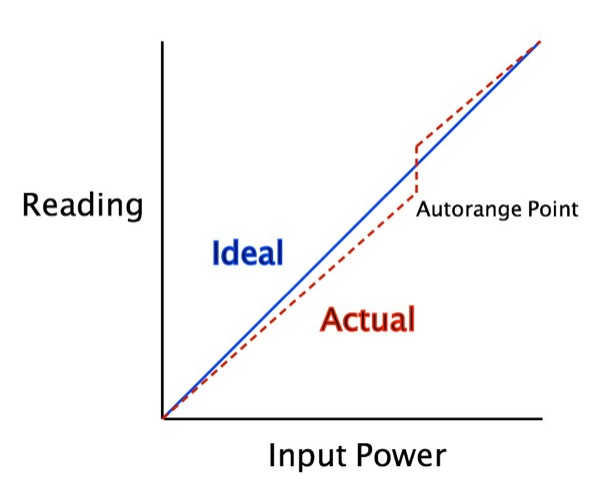
When the meter measures two power levels away from the autorange
point, the error is simply the error in the calibration slope,
which will be proportional to the range measured. For reading of
a few dB, the error is usually very small, ~0.0x dB. If the
measurement includes the autorange point, the error can be
higher, depending on the amount of error in the autoranging.
This argues for having your meters calibrated by a
factory-approved facility who knows where the autorange points
are and can carefully calibrate around them. If you just check
calibration at low and high points, you may miss autorange
problems.
How
to Clean POF (plastic optical fiber)
Q: I
heard that plastic fibres such as PMMA can suffer damage from
cleaning from an alcohol solution. Are there alternate cleaning
solutions available for these types of fibres."
A: You can use a 10/90
mix of isopropyl alcohol/water. Typically use with a lint
free swab. (from out POF consultants)
Testing
Bare Fibers With OTDR
Q: We are starting to test some OPGW cables. We have an
OTDR but we don’t find some reusable connectors. If we have to
test an OPGW with 48 fibres, we can’t set up 48 SC connectors!
Are there some reusable connectors in the commerce?
A: I assume you mean you
need to test with a bare fiber on the OPGW. For testing bare
fiber, use a splice, not a connector. Have a long pigtail on the
OTDR as a launch cable, long enough for the test pulse to
settle, say 100-500m, then use a splice for a temporary
connection. You can fusion splice the fibers then cut the splice
out or use a removable splice like the Corning Camsplice
(http://catalog.corning.com/opcomm/en-US/catalog/ProductDetails.aspx?cid=&pid=17929&vid=18219)
If you use a mechanical splice, you need a high quality cleaver
just like with fusion splicing and after several uses, you need
to add more index matching gel or liquid - mineral oil works OK.
See
the FOA page on Testing
Bare Fiber.
Is A Flashlight Test Adequate?
Q:
I contracted a firm to install an OM3 of 200 meters. On
one end I have an SFP 1000SX ,on the other a 1000SX
converter from optical to UTP. We made pings but they never
reached, and I didn’t see the laser at the extreme of the fiber.
They promised me to send me the certification they supposely
made ,though they assured me the fiber is ok, because WITH
A FLASHLIGHT THEY SENT WHITE LIGHT FROM ONE SIDE TO THE OTHER
AND IT WAS VISIBLE. I saw the light too, and I thought the
culprit was my switch or my SFP. I want to know: is this a good
demonstration that the fiber is ok?
A: A visual continuity
test is not adequate - your eye is not calibrated! The power of
the lamp is unimportant as each eye’s sensitivity is different.
And your eye probably cannot see the light from a 850nm VCSEL
source - most people’s eyes are not sensitive at that infrared
wavelength. The installer should have tested the link with a
light source and power meter (http://www.thefoa.org/tech/ref/testing/test/OFSTP-14.html)
and given you the loss in dB. The connectors should also be
inspected with a microscope to ensure proper polishing and
cleanliness
(http://www.thefoa.org/tech/ref/testing/test/scope.html). If the
SFP output is -6dBm, what is the power at the receiver?
1000base-SX is supposed to work with 4.5dB loss (see
http://www.thefoa.org/tech/Linkspec.htm). The fiber loss should
be ~0.6 dB, so you must have >4dB connector losses! That says
bad installation! The 1000SX link should work over 200m if the
fiber has been properly installed.
Older Fiber?
Q: I have some 62.5 mm and sm inside fiber plant over
20 years old. When is a good time to upgrade?
A: When you need to or
have to. If it's working OK, there is no need to upgrade!
"Connector Loss" or "Connection
Loss"
Q: I have always counted the loss of a connector as .75
dB (568B-3) and 1.5 for a mated pair. Is that correct?
A: While the industry
always says "connector" loss, it is actually "connection" loss.
As we explain in the page on termination and splicing (http://www.thefoa.org/tech/ref/basic/term.html)
When we say "connector" loss, we really mean "connection" loss -
the loss of a mated pair of connectors, expressed in "dB." Thus,
testing connectors requires mating them to reference connectors
which must be high quality connectors themselves to not
adversely affect the measured loss when mated to an unknown
connector. This is an important point often not fully
explained. In order to measure the loss of the connectors
you must mate them to a similar, known good, connector. When a
connector being tested is mated to several different connectors,
it may have different losses, because those losses are dependent
on the reference connector it is mated to."
The
TIA spec of 0.75dB is for a mated pair of connectors. If you
have been passing connectors tested @ 1.5dB loss....you may have
some very bad connectors in your cabling!
Changing
From OM2 to OM3/4 Fiber
Q: We have a system currently that is comprised of OM2
fibre with LED transceivers. There is a proposal to change the
fibre to OM3 and I have been asked to look at how the change
will affect the transceivers currently fitted which will remain
the same until a later upgrade. From looking around on
various forums I can see that OM3 is optimised for lasers,
however the existing hardware will remain as LED. My
understanding is that OM3 is simply fibre manufactured to a
better standard than OM2 with significantly less internal
defects. This leads me to think that switching from OM2 to OM3
fibre would not have any negative effect on the existing
hardware and would probably reduce the overall link loss.
I am also looking at whether we can use the same connectors,
again looking on the internet I can see that the physical
dimensions are the same, however are some connectors only
certified to OM2?
A: The difference
between OM2, OM3 and OM4 fiber is the "modal" bandwidth
potential of the fiber at 850nm. OM2 and OM3 fiber is optimized
for bandwidth with 850nm VCSELs and has no bandwidth advantage
with 1300nm LEDs. The optimization is done by more careful
manufacture of the graded index profile of the core of the
fiber, nothing else. There is no reason to use OM3 or OM4 fiber
with an LED transceiver as the LED cannot be modulated at high
speed and the LED bandwidth in any of these fiber is limited by
chromatic dispersion which is not significantly different in any
of the higher grade fibers. The attenuation coefficient of these
fibers is not enough different to justify replacement either.
See http://www.thefoa.org/tech/ref/basic/fiber.html
for more info on fiber. They all use the same connectors. Fiber
optic connectors are not a factor in the bandwidth of the fiber.
Microscope
Magnification (11/13)
Q: I am doing a lot of fiber optic jumpers for control
systems, either single mode or multimode. I want to get a
scope to inspect the ends after I clean them would you recommend
a 200X, 400X handheld or one similar to a Noyes OFS 300
200C?
A: We prefer to use
lower magnification and have a wider view so I can see more of
the ferrule to determine its condition. You can see the fiber
effectively at 100X but 200X may be better. 400X may be too much
for most tasks like inspecting for cleanliness, but may be good
if you are polishing SM for good reflectance. We've used the
Westover units for years because they offer two different
methods of illumination - direct and at an angle. If you are
doing a lot of patchcords, I recommend a video microscope. I've
used the Noyes unit that interfaces to a PC to create the FOA
Microscope Inspection YouTube video here: http://www.youtube.com/watch?v=IyumH8CiUPQ&feature=youtu.be
and it works well.
Recycling Cabling
Q: Who can I contact regarding recycling cable I am
removing from a building?
A: Here are some people
who say they recycle fiber optic cable or at least know how to
do it:
http://www.scottrecycling.com/complete.html
http://www.scrapmonster.com/selloffer/fiber-optic-cable/10400
http://www.dnvkema.com/services/ces/hse/recycling/recycling-cables.aspx
http://tmscrapmetals.com/Recycling.html
Tech
Hint: Did You Know You Have A Fiber Optic Tester In Your
Pocket?
Yes!
That old mobile phone has a camera which may be sensitive to
infrared light - lots more than your eye - and can detect
light in an optical fiber or from a transmitter. Chris
Hillyer,CFOT/CFOS/I, Master Instructor, Northern California
Sound & Communication JATC sent us some photos showing how
this works. See below
or the video
now on YouTube. Update: You should check out your old
cell phones before you recycle them. We've found older models
use sensors which are better at infrared than the newer ones
which take better pictures. This is a good use for your old
cell phones hiding in the drawer!
Fiber
Cleaning
This is a topic we keep reminding everybody about, and here is
why:
From
a contrator in the Middle East: Here some samples of the
connectors for SM fiber already installed in the system we were
testing.

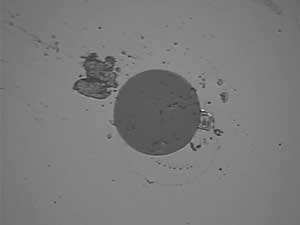
As
you can see, the dirt is large compared to the size of the fiber
(dark gray), and the core (not visible here) is only 9/125 of
the overall diameter of the fiber! More
on cleaning. See Product
News below for links to vendors of fiber cleaning products.
See
news about Fiber Optic Cleaning Videos on YouTube by ITW
Chemtronics below.
Fiber Optic Cleaning Videos on YouTube
See news about Fiber Optic Cleaning Videos on YouTube by ITW
Chemtronics three fiber optic cleaning videos on YouTUbe
covering Dry
Cleaning, Wet-Dry
Method, FiberWash
and Combination
Cleaning. They are good explanations of cleaning processes
- the Wet-Dry is especially interesting.
- Westover
Application Notes And Cleaning Video
- Westover
has several application notes on inspecting and cleaning
fiber optic connectors. The video is a big file (50+MB) but
a good tutorial.
- Download
page: http://www.westoverfiber.com/Support/downloads.php
-
Measurement
Uncertainty: Everyone testing fiber optics should understand
that every measurement has some uncertainty - whether you are
measuring loss, length, wavelength, power, etc. Knowing that
uncertainty is very important to interpreting the measurement.
It's worthwhile to read and understand the issue of measurement
accuracy covered in this
page of the FOA Online Fiber Optic Reference Guide.
RETURN
TO INDEX
Worth
Reading or Watching:
What Is The FOA?
Hear FOA President Jim Hayes tell the FOA Story in a 2-part
interview by Sound & Video Contractor Contributing Editor
Bennett Liles. It tells about the FOA history, goals and
achievements.
Part 1: http://svconline.com/podcasts/audio/fiber_optic_association_part1/index.html.
Part 2 http://svconline.com/podcasts/audio/inside-fiber-optic-association2-0924/index.html.
New
Textbook On Cleaning Fiber Optic Connectors
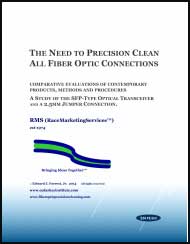
As fiber optic networks become faster and link margins lower,
cleaning fiber optic connectors has become more critical. Now
there is a book that gives really good information on cleaning
from a real expert.
Ed Forrest retired from ITW Chemtronics recently after many
years of being their expert on cleaning fiber optic connectors.
Ed has been one of our best contacts on the subject because his
knowledge is both broad and deep. When he retired, we suggested
he write a book on fiber optic cleaning and he took our advice.
Ed's book is like a cookbook, looking at specific cleaning
recipes, plus evaluating the tools commonly used for cleaning.
It's also in color which makes it easier to see what is being
done, although it makes the book a bit more expensive.
Now you can buy The Need to
Precision Clean Fiber All Optic Connections, A study of
the 'sciences of cleaning', contemporary cleaning products,
methods and procedures by Edward J Forrest Jr. The book is
available online from CreateSpace, the same publisher FOA uses.
Go here for more information on the book: https://www.createspace.com/5120367
What
Happens To Old Fibers?
In a recent web search, we found this article from Corning,
reprinted from a IWCS presentation in 1995. It discusses
extensive tests on a 1984 cable installed in the northern US to
see how it had degraded in almost 10 years. It is interesting to
see how the fiber survived OSP exposure. Read
it here.
Australia's
Standard Is Comprehensive Guide To Customer Cabling (Get your
copy free)
In
answering a recent technical questino, Trevor Conquest in
Australia pointed to the Australian Standard "Installation
Requirements For Customer Cabling." When we checked, it is on
the web and can be downloaded. It's a big book - 220 pages -
full of details for fiber and copper installations. We recommend
you download
yourself a copy - go here.
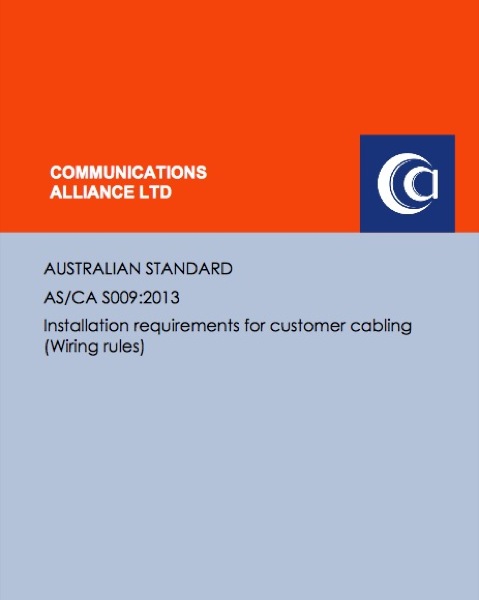
Demystify
fiber inspection probe technical specifications -
From EXFO
The
intent of this application note is to promote a better
understanding of video inspection probe specifications and
features. Properly understanding the key specifications
and features will greatly facilitate the decision process
involved in acquiring such devices. Understanding the key
aspects of fiber inspection probes will also help users
understand how fiber inspection probes operate, thus
enabling them to maximize the full potential of these
devices. Read
more.
Where
In The US Do Contractors Need Licenses For Fiber Optics?
We often
get asked where in the US do contractors doing fiber optic
installations need licenses. We found a good website for that
information, the NECA -NEIS website. You might remember
NECA-EIS, as they are the partner with the FOA in the NECA/FOA
301 Fiber Optic Installation Standard. NECA is the National
Electrical Contractors Association and NEIS stands for National
Electrical Installation Standards. They have a very easy to use
map and table that gives you data on every state in the US, so
mark these pages for future reference.
NECA/NEIS
http://www.neca-neis.org
(See “State Regulations”)
http://www.neca-neis.org/state/index.cfm?fa=state_regs
(all electrical licensing)
Low Voltage: http://www.neca-neis.org/state/index.cfm?fa=specialty_licensing
How Is
Fiber Manufactured?
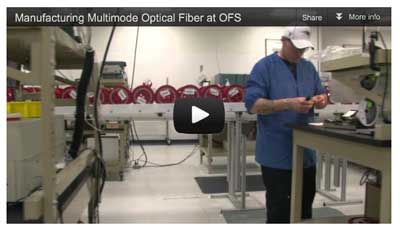
OFS invites you on a tour of their multimode fiber manufacturing
facilities in this new 5-minute video. You will see their highly
automated manufacturing operation in Sturbridge, Mass.,
including their patented MCVD preform fabrication process to
fiber draw and final product testing. With a technological
heritage dating back to AT&T and Bell Labs, OFS has been
manufacturing high-quality multimode fiber since 1981.
Watch
the video here.
Want To
Know Where Submarine Fiber Optic Cables Run?
There
is a good map online by TeleGeography you can access here.
Benchmarking Fusion Splicing
And Selecting Singlemode Fiber
We've been asked many times "How long does it take to splice a
cable?" It's not a simple answer as it varies with the number of
fibers in the cable and the work setup, including whether one or
two techs are working at a job site. FOA Master Instructor Joe
Botha of Triple Play in South Africa did his own analysis based
on decades of experience both splicing cables and teaching
others how to do it properly. This is one of the best analyses
we have seen because Joe includes prep times as well as splicing
times and differentiates between one tech and two techs working
together. He adds some other tips on fusion splicing too. This
should be mandatory reading for every tech and given to every
student! Here
is Joe's splicing analysis.
Joe also has an excellent writeup on how
to choose singlemode fiber that helps understanding
the different types of G.6xx fiber. Read
it here.
And you will want to read Joe's report on splicing
different types of SM fiber, including bend-insensitive
(G.657) fiber. Read
it here.
Free
- Mike Holt's Explanation Of The US National Electrical Code
(NEC) For Communications Cables
Mike Holt
is the acknowledged expert of the US National Electrical Code
(NEC). His books and seminars are highly praised for their
ability to make a very complicated standard (that is in fact
Code - law - in most areas of the US) easily understood. Part of
the appeal is Mike's great drawings that make understanding so
much easier. Mike makes Chapter 8 of his book available free. It
covers communications cables, telephones, LANs, CATV and CCTV,
for premises applications. Even if you live in a region or
country where the NEC is not the law, you may find this
interesting.
Download
Mike's Chapter Here.
Fiber
Optic Cleaning Videos on YouTube
ITW
Chemtronics has three fiber optic cleaning videos on  covering Dry
Cleaning, Wet-Dry
Method, FiberWash
and Combination
Cleaning. They are good explanations of cleaning processes
- the Wet-Dry is especially interesting.
covering Dry
Cleaning, Wet-Dry
Method, FiberWash
and Combination
Cleaning. They are good explanations of cleaning processes
- the Wet-Dry is especially interesting.
- Westover
Application Notes And Cleaning Video
- Westover
has several application notes on inspecting and cleaning
fiber optic connectors. The video is a big file (50+MB) but
a good tutorial.
- Download
page: http://www.westoverfiber.com/Support/downloads.php
-
A
Documentary Treasure on the History of the Internet
15
minutes of a rarely-seen BBC documentary demolish the myth that
ARPAnet was inspired by nuclear war, and explain the far more
intriguing truth.
http://www.technologyreview.com/blog/mimssbits/26719/?nlid=4433
Ensuring
Distance Accuracy On OTDR Measurements
By
JDSU.
JDSU
Reference Guide to Fiber Optic Testing
Volume 1 focuses on Basic Fiber testing and Volume 2 is geared
toward fiber optic installers, project managers, telecom
technicians and engineers who need to understand fiber networks.
Volume 2 also covers Chromatic Dispersion, Polarization Mode
Dispersion, Attenuation Profile and Fiber Link and Network
Characterization. A 3rd volume, a glossary of fiber optic terms,
is also available for download.
This is a "MUST HAVE" for all fiber optic techs. Download
your free copies here.
We used this book as one of our references in creating a new
page in the FOA Online Reference Guide on chromatic dispersion
(CD) and polarization-mode dispersion (PMD).
-
- Download
yourself a copy and read it!
-
Good
Technical Website For Installers
American
Polywater (http://www.polywater.com/)
has one of the best technical website for cable installers. Check
out their website, especially “Videos,” “Engineer’s Corner”
and “Calculators.” http://www.polywater.com/NNNBSL.pdf
Fiber
Optic Safety Poster
We've had numerous requests to reprint our guidelines
on safety when working with fiber optics, so we have
created a "Safety Poster" for you to print and post in your
classroom, worksite, etc. We suggest giving a copy to every
student and installer.
RETURN
TO INDEX

" Heard on the Street" is a monthly online newsletter from Frank
Bisbee of Communications Planning Corporation that covers
the telecommunications and cabling businesses. Each month
includes news from manufacturers, trade associations and
professional societies like the FOA. You can read the current
issue and back issues online.
IGI, a major market research and technology reporting company
(the "Active Optical Cables" below) is offering a a free
one year subscription to one of our fiber optics newsletters to
FOA members. All they have to do is to send IGI an e-mail
stating which newsletter they would like to get. See http://www.igigroup.com/nl.html
for a listing of IGI Newsletters.
RETURN
TO INDEX
-
FOA
Tech Topics -
A
Fiber Optic Tester In Your Pocket? (See the video on
 )
)
Yes!
The camera in your cell phone is sensitive to infrared light -
lots more than your eye - and can detect light in an optical
fiber or from a transmitter. Chris Hillyer,CFOT/CFOS/I,
Master Instructor, Northern California Sound & Communication
JATC brought this to our attention.
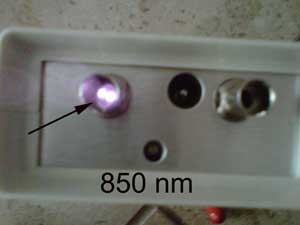
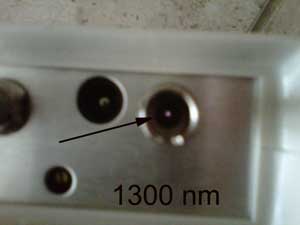
If
you have an old cell phone, try it too. Our experience is that
older cell phone cameras have better sensitivity at IR
wavelengths than newer phones, so you may want to toss that old
phone into the toolbox.
RETURN
TO INDEX
Product
News
YOKOGAWA
OTDR Has Extended range, High Resolution And Multitasking
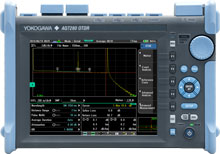
One OTDR manufacturer you don't hear as much about is YOKOGAWA
(formerly ANDO) which is too bad - they make some of the best
OTDRs, exemplified by this new model AQ7280. Need long range -
how about 50dB. High resolution - 0.6m dead zone. Like touch
screens, but for some functions want hard buttons, it's got
that. Options for VFL, microscope, light source and power meter,
etc. - it has that too.
But the unique aspect of the YOKOGAWA AQ7280 is it offers
multitasking - you can let do a trace with long averages while
you inspect connectors, make power readings, use the VFL or
other functions.
More
info on the YOKOGAWA AQ7280.
Need
A Fiber Optic Cable That's Waterproof And Floats?

Linden Photonics can help you. The specialize in special
underwater cables for towed vehicles or ROVs. Read
more.
How To
Make Space For More Cables In Full Conduits
Traditionally, underground fiber has been placed in plastic
innerducts in conduit. About a decade ago, MaxCell
"fabric" innerducts were introduced. They provided the
protection needed during installation and greatly increased the
availabe space in conduit. Recently, the company has introduced
an interesting technique to remove plastic innerduct in place to
make more space for cables in current ducts.
Here are photos from a MaxCell YouTube video showing what we are
describing.
Before, with innerduct in place:
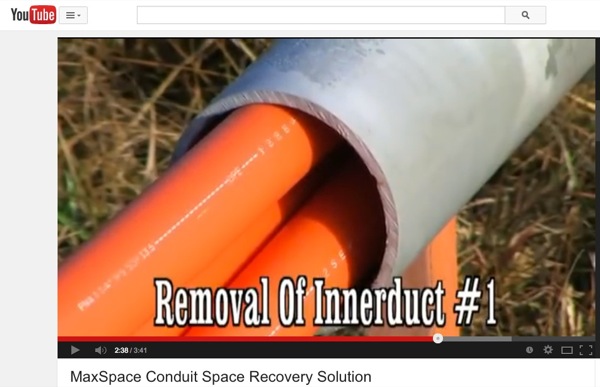
After, with
the MaxCell innerduct and more cables:
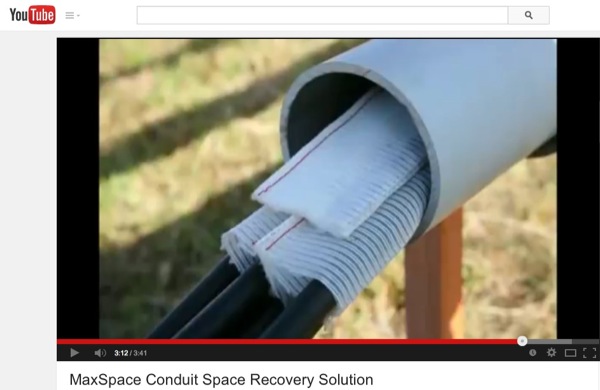
We suggest
you watch the overview: http://www.youtube.com/watch?v=sf726tPAvt8&list=PLDfVYzTi8g93zg1ZYWE-bINEeADVgEMsC&index=1
Then watch some actual examples of the innerduct removal
process: http://www.youtube.com/watch?v=Rs0bfd79AYM&feature=youtu.be&list=PLDfVYzTi8g93zg1ZYWE-bINEeADVgEMsC
A
Really Bright Visual Fault Locator
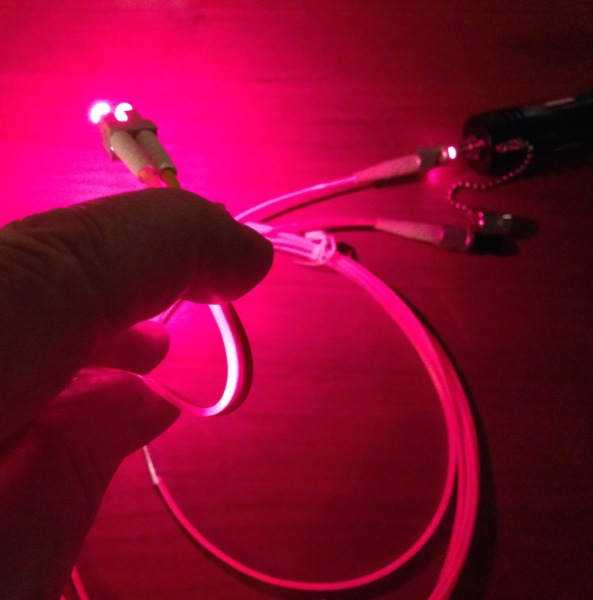
SKY
Technologies recently sent us a VFL to evaluate. With a VFL,
you need quite a bit of power to see splices and through some
cable jackets, even MM orange (the cable in the photo) but
especially other colors, so high power is an advantage. This
VFL is the brightest we have seen - bright enough that you
want to ensure it's aimed away from your eyes when you turn it
on! It has CE and RoHS approval. Model FT650H-50B. Contact SKY
for more information.
SKY
Technologies Inc.
http://skytechlasers.com
http://visualfaultlocator.net
1.888.878.2374
Switch
For Testing MTP/MPO Cables - Now
Available for 12 or 24 fiber MPOs
Fibernext has introduced a portable switch for testing
multifiber MTP/MPO connectors. You can also watch
the YouTube video here.
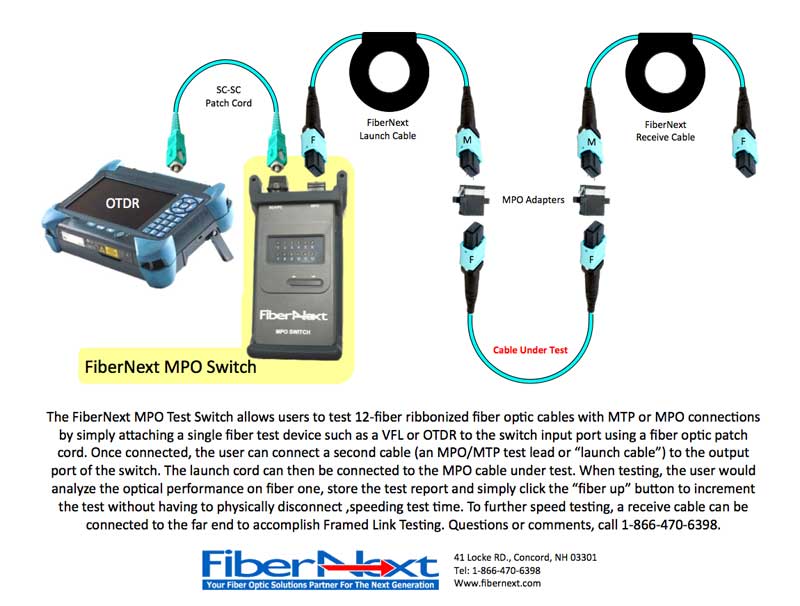
Recycling Communications Cable
FOA was
contacted by a company that recycles electronics communications
equipment and cabling. CommuniCom recycles
cable/metals/e-waste
for Telcos and CATVs. They also recycle Fiber Optic Cable and
associated Materials (the fiber scrap). And, they reclaim OSP
abandoned copper cables (abandoned from road moves or FTTx
growth). This is a huge part of our business. They do the work
(permitting/locates/labor) for free and we revenue share back
with our clients (telcos).
Contact
Steve Maginnis
smaginnis@communicominc.com
www.communicominc.com
803.371.5436 (cell)

Micro-Trenching, Cable
Removal
Nano-Trench
offers products for micro (or I guess they call it nano-)
trenching and their
website is very informative. They also have Kabel-X,
a method of extracting copper cables from old conduit. Both
websites are informative and interesting. Watch
this video on the cable removal process!
Protecting Pedestals From
Rodents
Pedestals
and underground vaults can be damaged by rodents who come up
through the base and damage cables. Uraseal "Drain N'Seal"
foam deters mice from taking up residence in your pedestals. They
have some good videos on using their product.
Used
Test Equipment – Buy or Sell
http://www.testequipmentconnection.com/
Have
you read the FOA
Tech Topics on Cleaning?
As
much as 70% of the problems associated with deploying fiber
result from something as simple as dirty connectors according
to JDSU. Telephony
Online.
US Conec's videos
on cleaning fibers - show's the results of proper
cleaning.
Westover
- AFL
ITW
Chemtronics
Cleantex
Alco Pads
MicroCare
Seiko-Giken
- RETURN
TO INDEX
FTTH
Notes:
Many
States In the US Restrict Municipal Networks
As reported
in the website "Community
Broadband Networks," many municipalities are creating
their own networks, including FTTH like Chattanooga and
Clarksville, TN, etc. But in 19 of the US states, there are laws
that handicap municipalities or outright ban their offering
"telecom" services. (See
the list of laws compiled by Optica here.) Obviously,
these laws were passed to protect the (usually monopoly) telecom
and CATV providers who do not want competition. But they also
make it difficult or impossible for many areas to get broadband.
Does anybody know if these laws prohibit a municipality from
building a fiber network and then leasing it to an Internet
service provider? Obviously, FTTH needs good lawyers too.
-
FTTH in
MDUs (Multiple Dwelling Units)
When we
talk about FTTH, we often assume we are installing the fiber to
a “home” where it terminates in a optical line terminal (OLT)
and services (voice, data and video) are delivered inside the
subscriber’s "home." But since we may have detached
single-family homes, row houses or living units in a large
building, the situations can be quite different, requiring
different architectures and installation practices. To clarify
the options for fiber in MDUs, FOA has created a new page in our
FTTx section of the FOA Guide to explain the options.
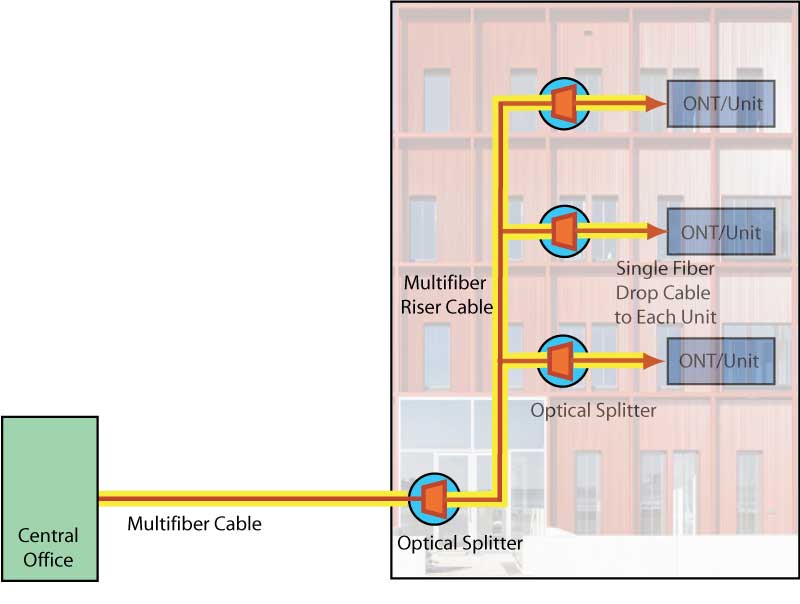
FOA
Guide: FTTH
in MDUs
Testing
FTTH
JDSU
shows how to test a PON with an OTDR: http://www.jdsu.com/other-literature/PON-OTDR_fop_an_ae.pdf
-
- Want
To Learn More About FTTx?
- The
FOA has created a special FTTx
resources section of our website with a FTTx
links page with lots of links to news, market reports,
technical articles and vendor technical and product
information. Here
is a great place to start learning more about FTTx.
- FOA's
CFxT FTTx Certification Program Explained
- Read
the Broadband Properties article about the FOA FTTx
certification program. Read
the article about FOA President Jim Hayes being honored
for his work promoting FTTH.
|
- RETURN
TO INDEX
-
Where
Are The Jobs In Fiber Optics?

The FOA was chartered to "promote professionalism in fiber
optics through education, certification and standards." Our
focus on creating a professional workforce to properly design,
install, maintain and repair communications network
infrastructure has led us to work with groups in many different
areas of technology that use fiber optics, way beyond the basic
telecom applications that most of us think of first. FOA has
probably worked with most of the potential applications of fiber
optics, but we're always learning about new ones!
In addition, we get lots of calls and emails from our members
looking for information about where the jobs are and how to
train for them. FOA has created three ways to help you find
jobs, train for them and apply for them.
Where Are The Jobs In Fiber
Optics?
FOA has created a 20 minute YouTube video that talks about all
the applications for fiber optics, what jobs are involved and
the qualifications for the workers in the field. Besides telecom
and the Internet, we cover wireless, cable TV, energy, LANs,
security, etc. etc. etc. It's a quick way to get an overview of
the fiber optic marketplace and we give you an idea of where the
opportunities are today.
Watch
the new FOA YouTube Video: Where Are The Jobs In Fiber Optics?
What Training Is Needed For The
Jobs In Fiber Optics?
As you will learn from the video described above, the jobs in
fiber optics are quite diverse. FOA has investigated these jobs
to understand the needs of workers for those jobs and, when
necessary, create curriculum and certifications to properly
train workers. For example, the FOA FTTx certification was
developed at the request of Verizon who needed specialized
installers for their FiOS program. Now we are working with the
industry on the OLAN (Optical LAN) program (see
below).
We have summarized the jobs and required training in a new web
page that has two uses - 1) If you have FOA certifications, what
jobs are you specifically qualified for? - 2) If you are working
in a specialized field or want to get a job in that area, what
training and certifications will qualify you for those jobs?
What
Training And Certifications Are Needed For Jobs In Fiber
Optics?
How To Find And Apply For Jobs
In Fiber Optics
We get many questions from CFOTs, students at FOA-Approved
schools and others contemplating getting into the fiber optic
business regarding jobs in fiber optics - and how to find them -
so we’ve created a new web page to share some information we've
gathered about jobs in our industry. The information is designed
to help you understand what jobs are available in fiber optics,
how to find them and apply for them.
If
you are looking for a job in fiber optics, here is the FOA's
guide to jobs.
We hope you find this useful. FOA tries to find new to increase
the professionalism in our industry and helping qualified people
find jobs is our highest priority - read the article below to
see why! If you have feedback on how we can help you and our
industry, contact us at info@thefoa.org.
Join FOA on 
A
list of 10 ways to get your resume noticed, from Marketplace
on NPR
Job
Openings
~~~~~~~~~~~~~~~~~~~~~~~~~~~~~~~~~~~~
Optical
Splicer Technicians who have FOA certifications, for a
project in Kingdom of Saudi Arabia
These Technicians will be working on of of the largest
National Broadband Rollout project in the Kingdom.
Position Objectives:
A Fiber Splicer is responsible for splicing, terminating and
testing aerial and underground fiber optic systems, updating
and maintaining project tracking information such as
production sheets, red-line as-built and customer required
paperwork. Additional responsibilities include
performing all aspects of the assigned project in accordance
with the clients’ standards and guidelines in the required
timeframe.
JOB DESCRIPTION & RESPONSIBILITIES:
·
Prepping and splicing of fiber optic cables in manholes and
handholes
·
Central Office fiber termination on distribution frames
·
Fiber splicing at customer locations such as telecom rooms,
risers, communication rooms…etc
·
Read and interpret OSP design drawings and fiber assignment
documents (GIS drawings, Fiber jointing schematics, GRANITE
tables…etc)
·
Update Fiber Jointing schematics with red-line as-buit
information regarding fiber splicing
·
Conduct complete fiber testing activities with OTDR, Power
meter and fiber detection equipment
·
Installation of optical splitters as part of a GPON network
·
Coordination with clients OSP design teams
·
Coordinating with clients customers for premises access,
fiber termination activities, MDT, equipment re-location…etc
·
Ensuring timely completion of projects as assigned.
·
Performing other related activities as assigned including,
but not limited to, telecom equipment installation, indoor
and outdoor cable installation, etc.
Qualifications
& Experience:
· Minimum of 3 years experience in Optical
fiber splicing
· FOA/CFOT certification or equivalent
· Proficient in use of all fibre optic
test equipment including OTDR, Power Meter, live fibre
tester, etc.
· Good knowledge of the GPON network
architecture and its related network components
· Experience with Optical fiber components
manipulation of different types such as, but not limited to,
Single and Multimode, ribbon fiber, micro cables, mechanical
splicing, optical splitters, termination equipment, OTDR’s
· Able to work unsupervised and under
restrained deadlines
· FOA/CPCT, FOA/CFOS or equivalent
certification an asset
KEYWORDS:
Splicing, FTTH, OTDR, OSP
Best regards
Kiran G Madhav
Talent Acquisition Specialist
Norconsult Telematics
+966 (0)503659600
kgm@norconsult.com.sa
~~~~~~~~~~~~~~~~~~~~~~~~~~~~~~~~~~~~
Senior
OSP- "Materials, Standards & Guidelines
Expert" in Saudi Arabia (11/2014)
We are hiring Senior OSP-
"Materials, Standards & Guidelines Expert" for our OSP
project in Saudi Arabia. The candidate must have 15+ years of
experience and profound knowledge of all aspects of the OSP
network (Standards, Guidelines, procedures, technologies,
equipment, tools) for planning, design and implementation in OSP
and Fiber.
Job Title: OSP Materials, Standards and
Guidelines Expert
Project/Department OSP
Position objectives Responsible for all OSP
Materials standardization, Standards, guidelines and their
related work procedures
Job Description and
Responsibilities
• Conduct market
analysis of OSP Design and implementation materials to find the
best suitable for CUSTOMER’S framework
• With the
support of CUSTOMER’S Management, Create and drive the functions
of the OSP Test LAB to R&D purposes
• Conduct
Benchmarking if required to asses optimal international
materials
• Evaluate
availability of materials with suppliers to best fit CUSTOMER’S
deployment plan
• Update and
maintain the standardized materials documentation and include
the installation procedures
• Evaluate
financial benefits of new standardized materials to reduce CAPEX
and OPEX spending
• Provide
training and support to all Regions to apply approved CUSTOMER’S
materials and their guidelines.
• Conduct
Benchmarking if required to asses international OSP Design best
practices
• Continuously
evaluate, review and update the OSP Design Standards and
Guidelines to meet international best practices that meet
CUSTOMER’S framework and optimize cost and quality of the
network deployment
• Leverage a
strong knowledge of technology trends for the selection of the
most cost effective and best practice access network solutions.
• Provide
continuous support and training for all OSP Design Standards and
Guidelines
• Conduct
Benchmarking if required to asses international implementation
best practices
• Continuously
evaluate, review and update the OSP implementation Standards and
Guidelines to meet international best practices that meet
CUSTOMER’S framework and optimize cost and quality of the
network deployment.
• Provide
continuous support and training for all design Standards and
Guidelines
• Create and
apply necessary processes and procedures to maintain and improve
the work efficiency/performance
Qualifications
- MSc in
Electrical/Civil Engineering or Bachelor’s degree in
Telecommunication Engineering with 15 + years’ experience
- Profound
knowledge of all aspects of the OSP network (Standards,
Guidelines, procedures, technologies, equipment, tools...etc)
for planning, design and implementation
-
Experience in a senior technical area of the OSP network
- Good
Presentation, Time Management and English Language skills.
-
Extraordinary technical writing skills
- Good
knowledge on General GSM/UMTS PSTN Network.
- In depth
knowledge of FTTx solutions and architecture, GPON as well as
PtP
- 6-10
Year of experience with network planning/design for access
networks
- Profound
experience with access networks civil works planning / design
- Broad
experience in working with OSP sub-contractors, design reviews
and quality control.
Contact
Kiran G Madhav
Talent Acquisition Specialist
+966 (0)540401285
kgm@norconsult.com.sa
Norconsult Telematics
~~~~~~~~~~~~~~~~~~~~~~~~~~~~~~~~~~~~
Outside Plant Fiber
Splicing Technician (10/14)
POSITION DESCRIPTION
TITLE: Outside Plant Fiber Splicing Technician II
DEPARTMENT: Outside Plant Fiber Splicing
SUPERVISOR: Outside Plant Fiber Splicing Supervisor
_____________________________________________________________________________
SUMMARY OF RESPONSIBILITIES: Perform various
duties as instructed within the network with regards to
outside plant construction, restoration, preventive
maintenance, facility locating, customer service drops and
record keeping.
ESSENTIAL FUNCTIONS:
1. Must be able to read splicing records and
splice fiber as directed by supervisor.
2. Must have a functioning knowledge of
testing and troubleshooting fiber optics.
3. Must be able to make as needed changes
and document test results.
4. Must be able to read engineering drawings
and correlate them to physical plant.
5. Must be able to assist in physical cable
placement.
6. Must assist in the coordination OSP
extensions and coordinate with other departments.
7. Perform detailed visual inspection of OSP
construction to determine quality of work being performed and
that it meets the company’s standards.
8. Other tasks or duties as assigned.
ADDITIONAL RESPONSIBILITIES:
1. Responsible for maintaining existing
fiber routes and facility locates as directed.
2. Responsible for maintaining all OSP
equipment, i.e. fusion splicer, trailers, vehicles.
3. Will complete no less than 2 trainings
classes per year as and when required.
EDUCATION/EXPERIENCE REQUIRED:
High School diploma or equivalent required. US Dept of
Labor approved technical certification in fiber optics
preferred. Must have at least 2 years work
experience related to the telecommunications industry with a
focus on fiber optic splicing and testing. Must have a
working knowledge of all types of outside plant
construction. Must possess a high degree of
interpersonal skills. Travel required.
PHYSICAL REQUIREMENTS/WORKING CONDITIONS:
Must be able to perform all physical and mental job
requirements with or without reasonable accommodation,
including driving, moving heavy weights (up to 50 lbs.),
distinguishing the fiber optic color code, bending, crawling,
working in confined spaces, climbing, working on overhead
equipment, use hand tools and specialized equipment, walking ,
standing, working in hot or cold and wet conditions.
Note: This is a brief description of the Outside Plant
Technician’s responsibilities and is not limited to those
described herein. Management retains the right to add,
delete or modify any of these responsibilities at any time
during
employment.
Revised 7/3/14 MT
Those interested can apply at their website www.cspire.com/careers
or can send their resumes to John Nordan jnordan@cspire.com
~~~~~~~~~~~~~~~~~~~~~~~~~~~~~~~~~~~~
Splicing
Techs Needed In Western Canada
Technicians needed, Western Canada (BC /AB). This is
primarily FTTH however any and all experience is welcome. Rate
of pay is 30-35/hr on rotational shifts which means 2 weeks on 1
week off. We travel throughout Alberta and British Columbia so
accommodations, and per diem are paid.
Candidates can contact us directly at: jane@dcltelecom.ca
Please contact the contractor directly at the email listed - not
FOA!
FOA
lists jobs and contracting opportunities on our LinkedIn
groups. CFOTs are invited to join.
Do listings in the FOA Newsletter Work? Here's feedback:
"We did great! We have over 15 interviews next week."
"Your newsletter generated a significant number of applicants
and we have filled the position."
RETURN
TO INDEX
-
|

















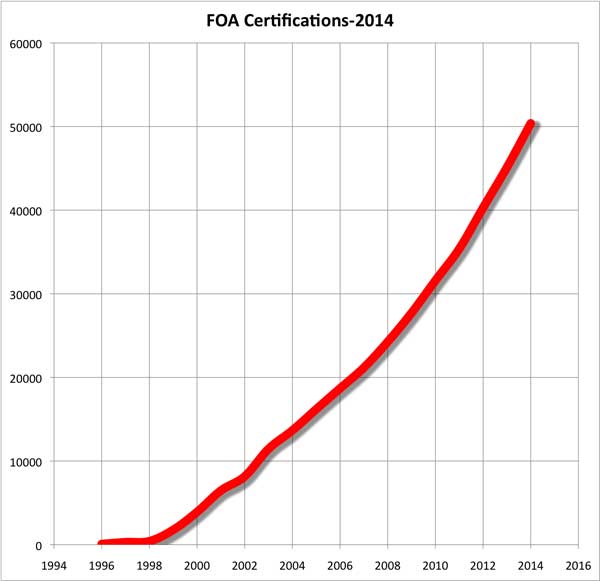














 Corporate
Memberships
Corporate
Memberships


































